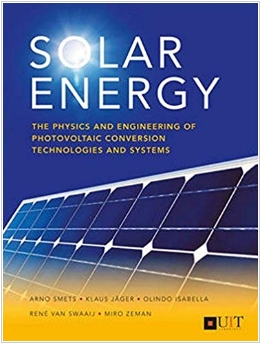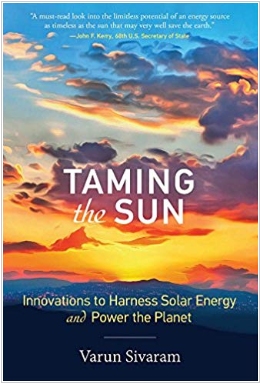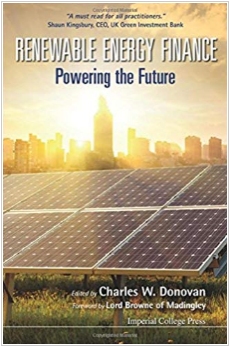3 Best books on Solar Energy
September 05, 2025 | Author: Maria Lin
Here is my list of 3 most interesting books about solar energy:
1. Solar Energy: The Physics and Engineering of Photovoltaic Conversion, Technologies and Systems

This book covers all aspects of solar energy from the photoelectric effect to the energy balance of the Earth. In particular, it provides interesting statistics on the dynamics of the global total capacity of solar power plants, which at the time of writing (2016) was growing exponentially. The largest share was installed in Europe. Then comes the Asia-Pacific region, where the bulk of the capacity is located in Japan (after the accident at the Fukushima nuclear power plant the Japanese government introduced a number of progressive feed-in tariffs to stimulate and accelerate the implementation of renewable energy technologies.). China, with a share of 13%, is the fastest growing market at the moment. About 26% of the world's PV capacity is in Germany (thought Germany is located in an area with relatively low solar radiation, comparable to Alaska). This is the result of the progressive feed-in tariff system introduced in Germany in 2000. Market growth is stimulated by the reduction in the cost of PV panels. On the one hand, industry is advancing to increase the energy conversion rate without increasing the cost price by better understanding production processes and increasing the yield of good products. On the other hand, it is learning to produce more efficiently, that is, to reduce labor costs per unit of production.
2. Taming the Sun: Innovations to Harness Solar Energy and Power the Planet

In this book, the author depicts two possible futures for the Earth in 2050. The bad version, where solar power has faded away and fossil fuels continue to hold the global economy in their grip. Coal and natural gas are still burned to generate most of the world's electricity, emitting carbon dioxide and other greenhouse gases into the atmosphere. Oil still powers most cars and trucks, as well as virtually all planes and ships, further polluting the air. But what had happened? After all, back in 2016, solar panels had become the cheapest source of energy on the planet and solar power was growing in popularity year after year. But in the 2030s the growth slowed. Part of the problem was that the falling cost of solar power was accompanied by a decline in its value: the electricity generated during daytime often did not match energy demand. In California, for example, solar panels covered demand during the day, but at the hour of greatest need, by dinnertime, the sun had already set. Some countries hoped for batteries, which were also becoming cheaper. But they were no panacea: they lasted for a few hours and were too expensive to use for long-term storage. Infrastructure, especially in developing countries, could not keep up with the construction of solar farms. India, for example, had difficulty connecting solar stations in the desert to its megacities. Even with solar panels installed on roofs, overloaded city grids could not withstand sudden surges in energy production. So by mid-century, solar energy's contribution to the world's energy supply remained limited and given the growth of human energy needs, it is still a small percentage compared to fossil fuels.
3. Renewable Energy Finance: Powering The Future

This book attempts to prove that solar energy is still the safe bet for investors. However, after the sharp fall of oil prices in the early 1980s, the renewable energy industry was almost destroyed. The significant investments in solar photovoltaics by major oil companies such as Exxon were sold off or abandoned and interest in the sector stagnated for almost two decades. By the end of the last century, only two countries – Japan and USA – were producing solar panels and overall investment in renewable energy was almost negligible. But now we see a much more promising picture. Growing energy security concerns, increasing environmental narratives and impressive technological innovations have changed the perception of solar and other forms of renewable energy. Countries are competing for a place in the global renewable energy supply chain. China, which was not even in the market 15 years ago, now invests more in renewable energy than the whole of Europe Union. Renewable energy attracts more than $200 billion in annual investment, almost as much as traditional fossil fuel energy sector. However, despite the positive indicators, there is a real risk of a reversal. Falling oil prices, budget austerity and the lack of international political agreement on climate change could once again cloud the outlook for renewable energy.
See also: Top 10 eBook Organizers
1. Solar Energy: The Physics and Engineering of Photovoltaic Conversion, Technologies and Systems

This book covers all aspects of solar energy from the photoelectric effect to the energy balance of the Earth. In particular, it provides interesting statistics on the dynamics of the global total capacity of solar power plants, which at the time of writing (2016) was growing exponentially. The largest share was installed in Europe. Then comes the Asia-Pacific region, where the bulk of the capacity is located in Japan (after the accident at the Fukushima nuclear power plant the Japanese government introduced a number of progressive feed-in tariffs to stimulate and accelerate the implementation of renewable energy technologies.). China, with a share of 13%, is the fastest growing market at the moment. About 26% of the world's PV capacity is in Germany (thought Germany is located in an area with relatively low solar radiation, comparable to Alaska). This is the result of the progressive feed-in tariff system introduced in Germany in 2000. Market growth is stimulated by the reduction in the cost of PV panels. On the one hand, industry is advancing to increase the energy conversion rate without increasing the cost price by better understanding production processes and increasing the yield of good products. On the other hand, it is learning to produce more efficiently, that is, to reduce labor costs per unit of production.
2. Taming the Sun: Innovations to Harness Solar Energy and Power the Planet

In this book, the author depicts two possible futures for the Earth in 2050. The bad version, where solar power has faded away and fossil fuels continue to hold the global economy in their grip. Coal and natural gas are still burned to generate most of the world's electricity, emitting carbon dioxide and other greenhouse gases into the atmosphere. Oil still powers most cars and trucks, as well as virtually all planes and ships, further polluting the air. But what had happened? After all, back in 2016, solar panels had become the cheapest source of energy on the planet and solar power was growing in popularity year after year. But in the 2030s the growth slowed. Part of the problem was that the falling cost of solar power was accompanied by a decline in its value: the electricity generated during daytime often did not match energy demand. In California, for example, solar panels covered demand during the day, but at the hour of greatest need, by dinnertime, the sun had already set. Some countries hoped for batteries, which were also becoming cheaper. But they were no panacea: they lasted for a few hours and were too expensive to use for long-term storage. Infrastructure, especially in developing countries, could not keep up with the construction of solar farms. India, for example, had difficulty connecting solar stations in the desert to its megacities. Even with solar panels installed on roofs, overloaded city grids could not withstand sudden surges in energy production. So by mid-century, solar energy's contribution to the world's energy supply remained limited and given the growth of human energy needs, it is still a small percentage compared to fossil fuels.
3. Renewable Energy Finance: Powering The Future

This book attempts to prove that solar energy is still the safe bet for investors. However, after the sharp fall of oil prices in the early 1980s, the renewable energy industry was almost destroyed. The significant investments in solar photovoltaics by major oil companies such as Exxon were sold off or abandoned and interest in the sector stagnated for almost two decades. By the end of the last century, only two countries – Japan and USA – were producing solar panels and overall investment in renewable energy was almost negligible. But now we see a much more promising picture. Growing energy security concerns, increasing environmental narratives and impressive technological innovations have changed the perception of solar and other forms of renewable energy. Countries are competing for a place in the global renewable energy supply chain. China, which was not even in the market 15 years ago, now invests more in renewable energy than the whole of Europe Union. Renewable energy attracts more than $200 billion in annual investment, almost as much as traditional fossil fuel energy sector. However, despite the positive indicators, there is a real risk of a reversal. Falling oil prices, budget austerity and the lack of international political agreement on climate change could once again cloud the outlook for renewable energy.
See also: Top 10 eBook Organizers



